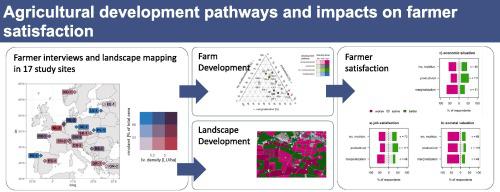当前位置:
X-MOL 学术
›
Glob. Environ. Chang.
›
论文详情
Our official English website, www.x-mol.net, welcomes your
feedback! (Note: you will need to create a separate account there.)
Divergent agricultural development pathways across farm and landscape scales in Europe: Implications for sustainability and farmer satisfaction
Global Environmental Change ( IF 8.6 ) Pub Date : 2024-05-23 , DOI: 10.1016/j.gloenvcha.2024.102855 Julian Helfenstein , Samuel Hepner , Amelie Kreuzer , Gregor Achermann , Tim Williams , Matthias Bürgi , Niels Debonne , Thymios Dimopoulos , Vasco Diogo , Wendy Fjellstad , Maria Garcia-Martin , Józef Hernik , Thanasis Kizos , Angela Lausch , Christian Levers , Jaan Liira , Franziska Mohr , Gerardo Moreno , Robert Pazur , Tomasz Salata , Beatrice Schüpbach , Rebecca Swart , Peter H. Verburg , Anita Zarina , Felix Herzog
Global Environmental Change ( IF 8.6 ) Pub Date : 2024-05-23 , DOI: 10.1016/j.gloenvcha.2024.102855 Julian Helfenstein , Samuel Hepner , Amelie Kreuzer , Gregor Achermann , Tim Williams , Matthias Bürgi , Niels Debonne , Thymios Dimopoulos , Vasco Diogo , Wendy Fjellstad , Maria Garcia-Martin , Józef Hernik , Thanasis Kizos , Angela Lausch , Christian Levers , Jaan Liira , Franziska Mohr , Gerardo Moreno , Robert Pazur , Tomasz Salata , Beatrice Schüpbach , Rebecca Swart , Peter H. Verburg , Anita Zarina , Felix Herzog

|
Current agricultural practices in Europe are increasingly aggravating societal and environmental safety concerns. This creates social and regulatory pressures on farmers, which can lead to declining material and social status of farmers, farmer discontent, and anti-regulation protests. These tensions are rooted in conflicting value systems for agricultural development, which can range from productivist pathways (i.e. valuing production above all else) to increasing multifunctionality pathways (i.e. valuing agriculture for its contribution to multiple economic, environmental and societal needs). It is largely unknown to what degree individual farms and agricultural landscapes are transitioning towards increasing productivism or multifunctionality in practice. Here, we mapped landscape changes and interviewed farmers (n = 274) to examine the diversity of agricultural development pathways in 17 study sites across Europe over the last 20 years (2000–2020). We also assessed the associations between the development pathways and farmers’ perceptions of socio-economic outcomes, namely job satisfaction, societal valuation, and economic performance. Farm-level development was largely aligned with productivist pathways, while landscape-level changes aligned more closely with an increasing multifunctionality pathway. Farmers on pathways of increasing multifunctionality did not perceive improved outcomes on livelihood indicators as compared to productivist farmers. Furthermore, farms on increasing multifunctionality pathways were concentrated in sites with very high management intensities that face strong pressure from environmental regulations, as well as low-intensity, mountainous sites, where opportunities for intensification are limited. These results suggest that current pathways that increase multifunctionality arise mostly by necessity. Successful agricultural transformation will therefore require policy to create enabling environments that provide socioeconomic benefits for farmers to increase multifunctionality, and a civil society and market conditions that value sustainable agriculture.
中文翻译:

欧洲不同农场和景观规模的农业发展路径:对可持续性和农民满意度的影响
欧洲当前的农业实践日益加剧社会和环境安全问题。这给农民带来了社会和监管压力,可能导致农民的物质和社会地位下降、农民不满和反监管抗议。这些紧张局势根源于农业发展价值体系的冲突,其范围可以从生产力主义途径(即重视生产高于一切)到增加多功能性途径(即重视农业对多种经济、环境和社会需求的贡献)。目前尚不清楚个体农场和农业景观在实践中向提高生产力或多功能性转变的程度。在这里,我们绘制了景观变化图并采访了农民 (n = 274),以研究过去 20 年(2000 年至 2020 年)欧洲 17 个研究地点农业发展路径的多样性。我们还评估了发展路径与农民对社会经济成果(即工作满意度、社会评价和经济绩效)的看法之间的关联。农场层面的发展在很大程度上与生产力主义路径保持一致,而景观层面的变化则与日益增长的多功能性路径更加紧密地结合在一起。与生产主义农民相比,采取增加多功能性途径的农民并没有认为生计指标有所改善。此外,多功能化道路上的农场集中在管理强度非常高、面临环境法规压力的地点,以及管理强度低、集约化机会有限的山区。 这些结果表明,当前增加多功能性的途径主要是出于必要而出现的。因此,成功的农业转型需要政策创造有利环境,为农民提供社会经济效益,以增强多功能性,并需要重视可持续农业的民间社会和市场条件。
更新日期:2024-05-23
中文翻译:

欧洲不同农场和景观规模的农业发展路径:对可持续性和农民满意度的影响
欧洲当前的农业实践日益加剧社会和环境安全问题。这给农民带来了社会和监管压力,可能导致农民的物质和社会地位下降、农民不满和反监管抗议。这些紧张局势根源于农业发展价值体系的冲突,其范围可以从生产力主义途径(即重视生产高于一切)到增加多功能性途径(即重视农业对多种经济、环境和社会需求的贡献)。目前尚不清楚个体农场和农业景观在实践中向提高生产力或多功能性转变的程度。在这里,我们绘制了景观变化图并采访了农民 (n = 274),以研究过去 20 年(2000 年至 2020 年)欧洲 17 个研究地点农业发展路径的多样性。我们还评估了发展路径与农民对社会经济成果(即工作满意度、社会评价和经济绩效)的看法之间的关联。农场层面的发展在很大程度上与生产力主义路径保持一致,而景观层面的变化则与日益增长的多功能性路径更加紧密地结合在一起。与生产主义农民相比,采取增加多功能性途径的农民并没有认为生计指标有所改善。此外,多功能化道路上的农场集中在管理强度非常高、面临环境法规压力的地点,以及管理强度低、集约化机会有限的山区。 这些结果表明,当前增加多功能性的途径主要是出于必要而出现的。因此,成功的农业转型需要政策创造有利环境,为农民提供社会经济效益,以增强多功能性,并需要重视可持续农业的民间社会和市场条件。











































 京公网安备 11010802027423号
京公网安备 11010802027423号